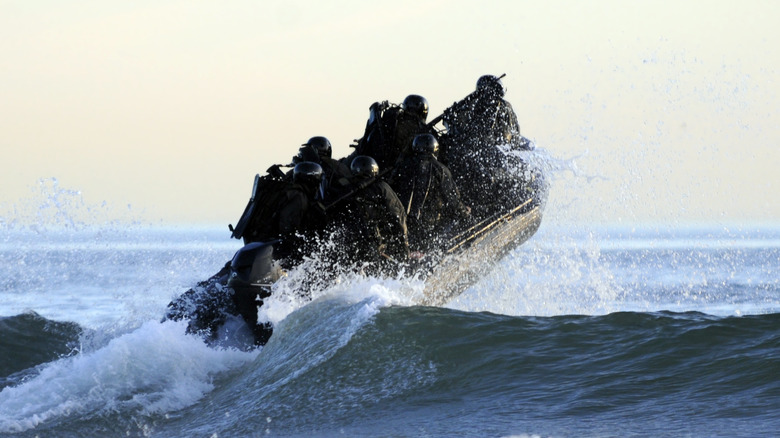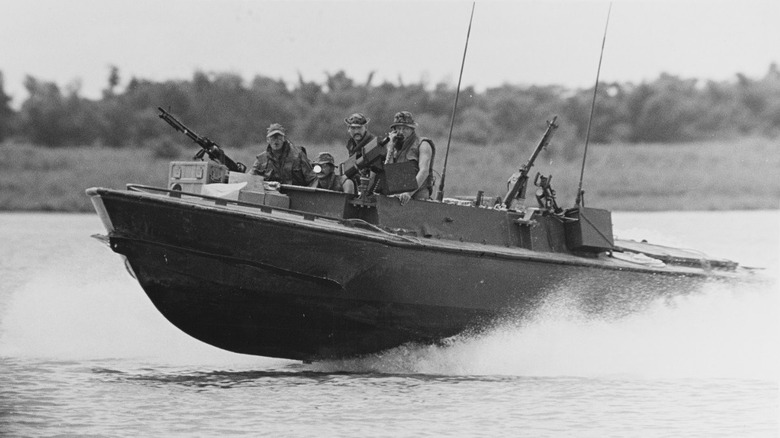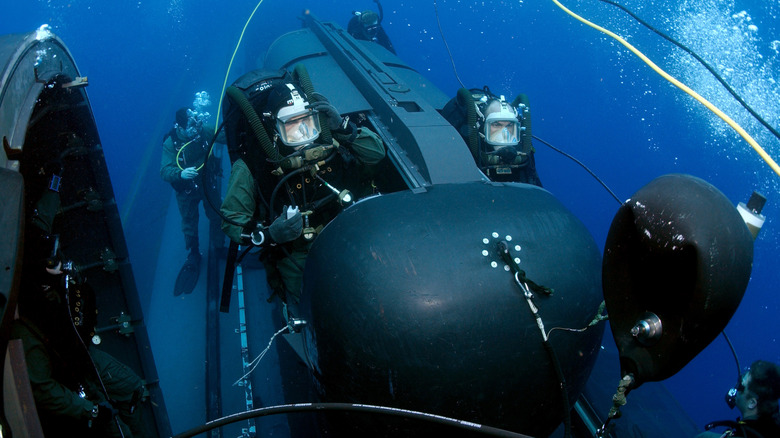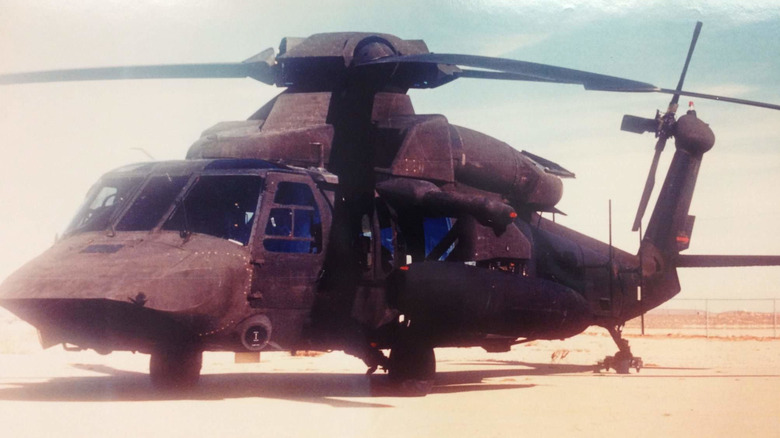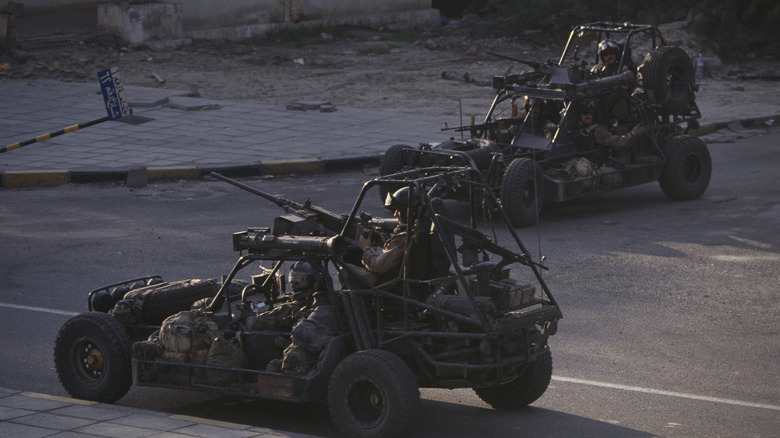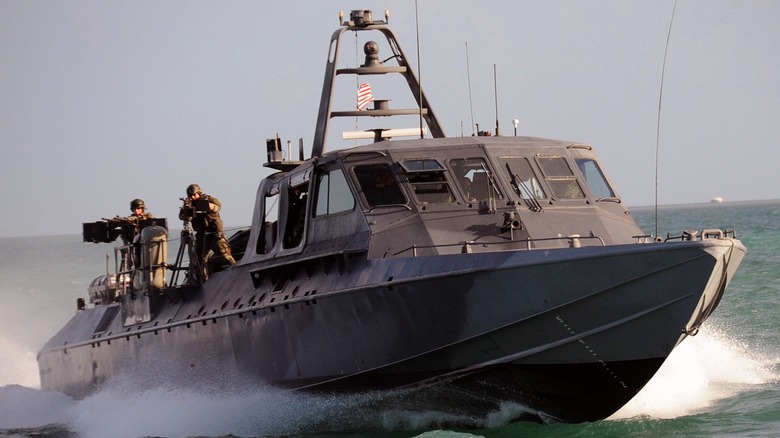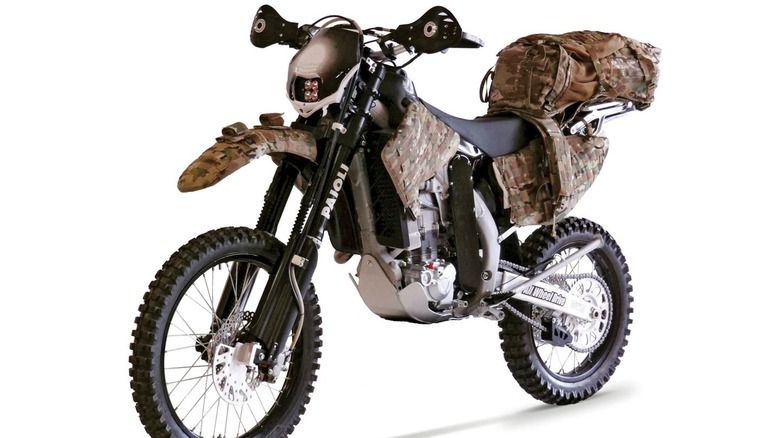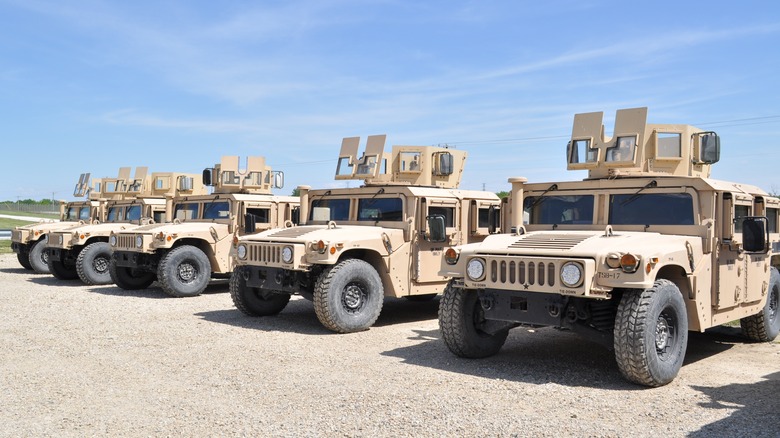7 Awesome Vehicles Used By SEAL Teams
As one of the nation's most elite special operations units, the Navy SEALs are tasked with executing some of the most demanding, challenging, and complex military operations in the world. The work is far from easy, requiring a level of commitment and resilience beyond the imagination of most civilians.
Navy SEALs operate anywhere. The very name of the unit attests to that; SEAL is an acronym for sea, air, and land, a promise that no matter the terrain or environment, if a SEAL wants to get there, they will. But they won't always be doing it on foot. As a top priority of the Navy, the SEAL teams are well-funded and have access to some of the most advanced gear and vehicles in the world.
Fighting well is only part of the challenge of military operations. Maritime commands like SEALs need to reach some of the most inhospitable areas on the globe quickly and often stealthily. To this end, the SEALs have helped develop several custom vehicles to get them into the fight no matter where it is. Let's review seven of the coolest vehicles SEAL teams use to get to battle.
SEAL Team Assault Boat (STAB)
After fighting near-peer conventional enemies during the Second World War and Korea, the United States found itself initially prepared for tank warfare in the Vietnam War. However, the thick terrain of Southeast Asia's jungles demanded fresh tactics and new equipment. The United States Navy was primarily deep-water oriented — its ability to penetrate Vietnam's labyrinthine river systems was virtually non-existent. The SEALs' answer was the STAB.
Also known as the Strike Assault Boat or SEAL Team Assault Boat, the STAB was the brainchild of Admiral Elmo R. Zumwalt Jr. — the youngest officer to assume the position of Chief of Naval Operation, at the age of 50 in 1970. The STAB boats, with their requirement for a small draft and powerful engines, were designed to navigate the coastal creeks and rivers of Vietnam.
The U.S. Navy tasked Grafton Boatworks with developing the STAB based on the Light Seal Support Craft (LSSC). Grafton lengthened the LSSC by two feet to 26 feet and installed a pair of 427 cubic-inch Chevrolet V8s. With a draft of a mere two feet, the seven-ton craft was capable of more than 40 knots, making it the fastest boat deployed to Vietnam.
STAB boats were not known for stalwart armor but relied on speed and surprise to disrupt enemy operations and. SEALs utilized STABs to penetrate enemy territory, insert teams for patrols, harass enemy fighters, or interdict riverine traffic.
[Featured image by National Archives USN 1146258 photographer, Chief Photographer's Mate L. Bernard Moran via Wikimedia Commons | Cropped and scaled | Public Domain]
Seal delivery vehicle (SDV)
Surface watercraft aren't the only method SEALs use to infiltrate. Though expert divers, swimming all the way to an objective is exhausting, especially when the fighting doesn't even start until you get there.
A Seal delivery vehicle (SDV) is a mini-submarine designed to deliver SEALs underwater without relying on flipper power. The Navy initially wanted each SEAL team to have its own complement of SDVs. However, the specialized piloting skills and large amounts of maintenance required for operation forced them to set up teams dedicated to SDV operation.
SDVs are unpressurized submersibles, so the up to six-man crew is exposed to seawater, breathes from the onboard air supply, and has limited communication. SDV missions can last several hours, as the mini-sub may deploy a team of swimmers and loiter in the area to aid with exfiltration.
The current SDV — the Mark VIII — is slated to be phased out in favor of an updated Mark 11. The Mark 11s will have improved range, better communications equipment, and the ability to carry two pilots and a team of four combat divers with a maximum depth of 165 feet.
The utilization of SDVs in real-world operations is classified. By nature, SEALs deploy SDVs to denied-access areas. In other words, you won't hear much about SDV operations unless you go looking. They are often used to deliver SEALs to places they aren't necessarily supposed to be.
[Featured image by U.S. Navy photo by Chief Photographer's Mate Andrew McKaskle via Wikimedia Commons | Cropped and scaled | Public Domain]
MH-X Stealth Hawk Helicopter
The 2011 raid that killed Osama Bin Laden in Abbottobad, Pakistan helped push the SEAL teams into the public eye whether the Navy wanted it or not. The SEALs on the mission completed the objective without incurring any casualties, but that doesn't mean everything went perfectly. When dawn of the following day arrived, the SEALs who carried out the raid were already well away, but they left behind a very interesting remnant of the mission.
On the ground outside the compound, an alien-looking piece of equipment remained: the tail rotor of a helicopter. One of the helicopters ferrying the SEALs to the mission had crashed upon infiltration, its tail caught on one of the high walls. The teams blew it up to prevent enemy capture before leaving on another helicopter, but the tail rotor fell largely undamaged outside the wall.
And it wasn't any ordinary tail rotor. It had an unusual material covering it that looked suspiciously like stealth technology. The first American stealth aircraft — the F-117 Nighthawk — had been around since 1981, though the public did not know about it until 1988. It seemed that the same protocol protected the existence of this Stealth Hawk helicopter.
The Navy sent Sikorsky UH-60 Blackhawks modified for quieter operation — though it didn't prevent a local man from tweeting about it — and with what appeared to be an anti-radar reflective coating on the rotor assembly. If it weren't for the unfortunate crash landing on the Bin Laden raid, we might not even be aware of its existence at all.
[Featured image Uncredited via Wikimedia Commons | Cropped and scaled | CC BY-SA 4.0]
Desert patrol vehicle (DPV)
Bombing through the desert on a dune buggy can be great summer driving, but how about doing it in a combat environment? With the two major American wars of the 20th century occurring in arid climates, SEALs needed a way to traverse the desert quickly and effectively.
The DPV dune buggy has been part of the SEAL auto pool since at least Operation Desert Storm, though it was then known as the fast attack vehicle. A 200-horsepower, 2-liter, air-cooled Volkswagen engine powers the current version. Its open sides and tubular frame leave much to be desired in the armor category, but light handling and an off-road suspension help it quickly traverse rugged terrain at a top speed of 80 mph.
Weighing just over a ton at 2,110 pounds, the DPV dune buggy can handle a combat payload of an additional 1,540 pounds. Its reliability is not the only factor that makes it a valuable asset. The DPV is designed to be adaptable, capable of being modified to suit mission requirements. Its armament can range from .50 caliber heavy machine guns, 7.62 or 5.56 light machine guns, an automatic grenade launcher, or a combination of all three.
The DPV dune buggy is designed to accommodate three SEALs at a time: a driver, a passenger, and a third in the rear to operate the main gun. With a single tank of gas, the DPV can cover a range of 210 miles. An external fuel bladder can extend its range to an impressive 1,000 miles, enhancing its operational capabilities in extended missions.
Mk V Special Operations Craft (SOC)
The STAB boat did its job in the Vietnam era, but much water has passed under the bridge since then. Ever on the cutting edge of technology, SEAL teams spent the intervening years developing a series of upgraded special operations watercraft.
The Mk V Special Operations Craft, a crucial component of SEAL operations, is entrusted to Navy Special Warfare Combatant Crewman (SWICC) teams. These teams skillfully operate the boats for a range of missions, including insertion, extraction, reconnaissance, and coastal patrol.
Measuring 82 feet in length, the Mark V SOC can accommodate up to five SWICC members and 16 SEALs, along with their combat load. Unlike the conventional rubber dinghies associated with SEAL teams, the robust Mk V SOC performs medium-range operations, capable of patrolling more than 550 nautical miles. Its performance is driven by a pair of MTU 12V-396-TE94 V12 maritime engines, each generating over 2200 horsepower, propelling the craft to a maximum speed of 65 knots (75 mph).
The Navy organizes its Mk Vs into units of two boats, along with the equipment and crew required to operate them. SEAL Command can prepare a detachment to deploy anywhere in the world with 48 hours' notice and be ready to operate within an additional 24 hours.
[Featured image U.S. Navy photo by Chief Mass Communication Specialist Kathryn Whittenberger via Wikimedia Commons | Cropped and scaled | Public Domain]
Christini all wheel drive 450 Dirtbike
If you thought the dune buggy was cool, hold on to your hat. All-terrain vehicles and dirtbikes are excellent ways to go where the road doesn't. And in the rough-and-tumble countryside of some of the most desolate places on earth, warfighters don't have the luxury of packing it up and going home.
Philadelphia-based contractor Steve Christini has been building specialized ATVs for over twenty years. Aside from four-wheelers that can spin on a dime, Christini has also developed a front-wheel drive system for dirt bikes and motorcycles. The extra drive wheel adds to the ability to traverse inhospitable terrain. After years of testing, the military reported that operating one in rough conditions is less fatiguing for operators, praising its durability, maneuverability, and performance in challenging environments.
SEAL Team 2 deployed the Christini AWD 450 dirtbike in Afghanistan back in 2012. Christini has remained at the wheel — er, handlebars — developing updated models as the years passed. A civilian version of the all-wheel drive bike, the Christini 450 E, is available, though it's more expensive than similar offerings from Kawasaki, Honda, Suzuki, and Yamaha (without the extra drive wheel, of course) at $15,500 MSRP.
Every edition comes with a liquid-cooled 450 cc engine, tuned suspension, and aluminum exhaust system, but military teams can add a plethora of customized parts depending on the unit's needs. The military edition starts at $17,500, but maybe you can get a deal if you order, say, a battalion's worth.
High mobility multipurpose wheeled vehicle GMV-N
The classic high-mobility multipurpose wheeled vehicle, better known as the Humvee, has symbolized the United States military presence from the mid-1980s through the recent war on terrorism in Afghanistan and Iraq. Developed by General Motors and with domestic and military models available to civilians for several years, its reputation has seen ups and downs.
The classic military Humvee was equipped with either a 6.2-liter V8 or 6.5-liter turbo-diesel engine and had a top speed of 70mph. Though heavy, at 5,200 pounds curb weight, the thin-skinned Hummers struggled against armor-piercing weaponry and even small-arms fire.
Naturally, the specialized Navy SEAL units weren't happy with any standard Hummer off the lot. A patrol Humvee was modified for the Seals' missions. Multiple combat teams got customized Hummers: the Marines GMV-M, Army Rangers GMV-R, and Army Special Operations Command GMVS-SOF.
The SEALs' GMV-N could carry as many as five SEAL personnel, all of whom underwent a four-week training course on maintaining and deploying the vehicle. The GMV-N included modular armor and, similar to the Desert Patrol Vehicle, could be equipped with various machine guns and grenade launchers. The military began phasing out the Humvee for armored vehicles that could better survive roadside bombs.
